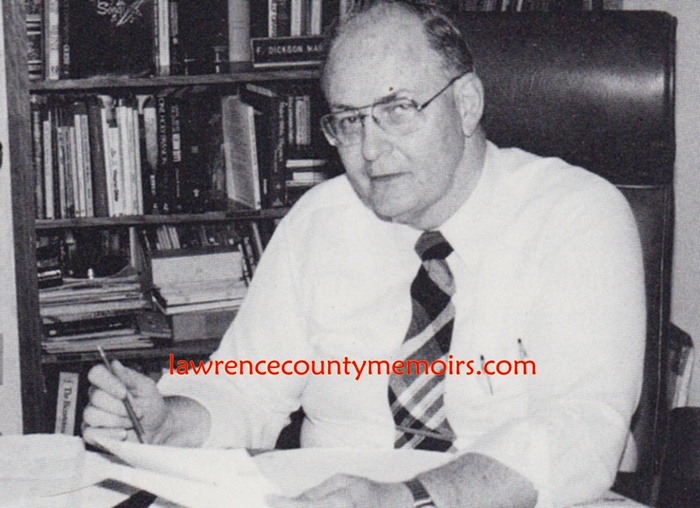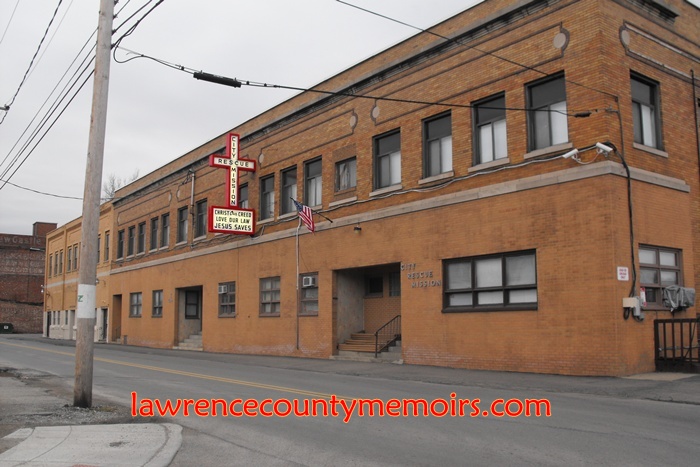In September-October 1910 the Reverend Billy Sunday, the most famous evangelist of his time, brought his crusade to New Castle, Pennsylvania, to spread his message of the importance of pure living and helping the less fortunate members of society. One of the things Sunday preached about was how he was “saved” at a rescue mission in Chicago in 1887. In the wake of his visit various religious-minded local men formed the Men’s Personal Workers League, a group who met regularly at the Youth Men’s Christian Association (YMCA) and traveled to provide evangelical and humanitarian work wherever it was needed. I believe one of the goals of this group was to establish a religious-based rescue mission in New Castle.
In October 1911 the Reverend Melvin “Mel” Trotter, a well-known evangelist and mission worker from Michigan, arrived in New Castle to help set up such a facility for the homeless and other less fortunate folks of the city. He was primarily assisted by Robert McKinney, a prominent member of the Personal Workers League and one of the founders of the New Castle Notions Company. A successful fundraising service was held at the First Baptist Church on the evening of October 18, 1911. A board of directors was established, whose members were drawn from various churches from around the city.
The new rescue mission was initially housed in the basement of the New Castle Notions Company building alongside the Mill Street Bridge, but less than two weeks later was moved across the street into the Marshall Block building on South Croton Avenue. In November 1912 it moved down the street into the Dufford Block building near the East Washington Street Bridge. Edward J. Berquist (1882-1935), who previously headed up a rescue mission in Sharon, served as the first superintendent. The mission provided meals, sleeping quarters, and religious services for the homeless and destitute, as well as other vital endeavors such as distributing clothes for the poor children of the city and offering drug and alcohol rehabilitation assistance. The mission gained considerable acclaim during the Great Flood of March 1913, when it helped provide food, clothing, and shelter to the numerous displaced persons in downtown New Castle.
The mission was officially incorporated in March 1921 as the City Rescue Mission of New Castle. About three years later, in June 1924, the board of directors purchased the old Vendome Hotel on South Mercer Street for $25,000. A remodeling effort was soon undertaken to transform the building into the new home of the Rescue Mission. An article in the New Castle News of December 20, 1924, reads in part, “The building is being thoroughly renovated, repairs being made on each floor. On the first floor will be the offices and meeting room. On the second floor will be the rooms for the caretaker and on the third floor will be the rooms for the guests, some of whom no doubt will be the gentry who seek a free flop on chilly, wintry evenings.”
The same article elaborates with, “One of the first jobs necessary by the reconstruction men was the cleaning out of the cellar under the old bar room. Paint your own picture as to what the boys found. Long necked bottles and short squatty bottles, brown bottles and light colored bottles. Bottles that had held beer and wine and liquor and other potent drinking beverages. Oh yes, the bottles were empty… The building is being thoroughly renovated, repairs being made on each floor. On the first floor will be the offices and meeting room.”
Berquist guided the Rescue Mission through its first seventeen years, being succeeded by Benjamin J. Watkins who served from 1928-1937. Subsequent superintendents over the next decade included Archie W. Gibson, Donald W. Wert, and Cyril “Cy” Smith. The mission thrived in the 1920’s, simply survived during the tough times of the 1930’s, and rebounded in the midst of the war torn years of the 1940’s.
In 1949 the board of directors hired twenty-three-year-old Reverend F. Dickson Marshall, a World War II veteran and recently ordained minister, as its new superintendent. Under Marshall’s reign, which would span almost five decades, the Rescue Mission experienced a period of great prosperity. In the early 1950’s an Industrial Department, designed to gather, store, and distribute second hand clothing and furniture from public donators, was established. It also operated several thrift shops and a recycling program. The social services-type Family Welfare Department was also established as an outreach program for the community. In addition the superintendent’s wife, Mrs. Phyllis Marshall, launched the Woman’s Auxiliary Group, a group of female volunteers who supported the various programs of the mission. In September 1957 a new building, mainly serving as a warehouse and workplace skills training facility for the Industrial Department, was opened on Cascade Street.
During the summer of 1961, the same year the Rescue Mission would celebrate its 50th anniversary, the board of directors were actively seeking a much larger home for the mission. An article in the New Castle News of June 22, 1961, reads in part, “Housing 12,000 men over a year’s time is no small matter and safety and health factors must be considered… The mission currently has facilities to sleep approximately 30 men nightly and during the winter months some men are forced to sleep on the floor if they are to be in out of the cold. The proper dining room and kitchen facilities are also a factor in order to provide food well cooked for the men who apply for aid… This past month alone, when 1,012 men slept at the mission, of this number, 15 were World War I veterans and 152 were World War II veterans.”
On Friday, November 10, 1961, during a 50th anniversary banquet at the Northminster United Presbyterian Church, it was announced that Rescue Mission officials had reached a deal to purchase a spacious building on South Croton Avenue for $40,000. The building, sometimes referred to as the Crawford-Wallace Building, was once home to Castle Sales & Appliances – and was currently home to several businesses including the offices of the Lawrence County Board of Public Assistance. The Rescue Mission starting renovating this building in early December 1961 and began moving in by the end of the year. A few months later the Spencer Paint & Glass Company opened up shop in the old Rescue Mission property on South Mercer Street.
The mission needed special permission to erect its trademark cross-shaped lighted sign on its new building. I believe this was due to the smaller than usual sidewalk area along South Croton Avenue. An article in the New Castle News of January 24, 1962, reads, “Council approved a building variance to the City Rescue Mission to erect a cross above their new quarters on S. Croton Ave. Razzano (Director of Streets and Public Improvements D. John Razzano) recommended permission be granted after Solicitor Marjorie A. Young ruled the city would have no liability if the sign were involved in an accident. He said the city requires signs to be two feet within the curb line but the cross would be only one foot inside.”
On Sunday, April 7, 1962, the new Rescue Mission, and its McKinney Memorial Chapel, was dedicated during a ceremony presided over by the Reverend Marshall. Meanwhile, work continued on remodeling other portions of the large building.
In early 1965 the Rescue Mission established the Sankey Youth Center, named in honor of singing evangelist Ira D. Sankey. The program was designed to keep young boys “off the streets” by getting them involved in such endeavors as swimming, basketball, gymnastics, crafts, religious study, and field trips. In the late 1967 the Youth Center moved into its own building across the street from the Rescue Mission. The building, which had been donated by the Citizen’s National Bank, was renovated by volunteers and dedicated in November 1967.
Further expansion took place in the coming decades. In May 1974 the Rescue Mission paid $37,500 to acquire Camp Eastbrook, a YWCA-run summer camp located in Hickory Township. It was renamed as Sherman Acres in honor of Mr. Ralph J. Sherman, a longtime member of the Rescue Mission board of directors who was killed in a car accident with his wife Elsie in October 1973. The 31-acre facility was put in use as a day camp for kids during the summer months and a year-round recreation area for adults.
In 1976 the Ramsey Hardware building, located just across the street, was acquired by the mission for use as an auxiliary space. In 1983 a 10-acre site was acquired on the West Side, which was used to establish the Covenant House – a 16-bed emergency shelter for woman and children. Years later a similar facility was opened for homeless men with children. In 1995 the Sankey Memorial Education and Recreation Center was opened in a large building on Grant Street. Additional facilities were opened – and some older ones closed – in the coming years.
In 1996 the Reverend F. Dickson Marshall, after forty-seven years in the position of Superintendent – or Executive Director-Pastor (as it was renamed in 1965) – stepped down to take a reduced role with the Rescue Mission. The Reverend Jerry Marshall succeeded him. Three years later F. Dickson Marshall retired after a remarkable fifty years of service to Rescue Mission and the people of New Castle. In 2000 the Reverend Kevin A. Green was appointed to head the agency on an interim basis to succeed Jerry Marshall, and assumed the fulltime post of Executive Director and Chief Executive Officer a year later.
On November 10, 2011, the hardworking people associated with the Rescue Mission celebrated its 100th anniversary during a ceremony and service held at the First Presbyterian Church in New Castle. Today, the Rescue Mission continues its humanitarian services not only for the less fortunate people of New Castle and Lawrence County, but also assists in similar endeavors in the neighboring counties as well.
 The Reverend F. Dickson Marshall (1926-2000), who was born in Ontario, Canada, was hired as the superintendent of the City Rescue Mission in 1949. The facility grew immensely under his leadership, which spanned almost five decades. He stepped down as superintendent (or Executive Director-Pastor as it was then called) in 1996 to take a reduced role. He retired for good in 1999 after a remarkable fifty years for service to the less fortunate members of the community. He remained involved in local religious circles until his death at the age of seventy-five in October 2000. (c1980) Full Size |
 A view of a dormitory inside the Rescue Mission. (c1965) Full Size |
 In late 1961 the Rescue Mission moved into its new home in the old Wallace-Crawford Building (shown above) on South Croton Avenue – a location it still occupies today. (Mar 2012) Full Size |
 (Mar 2012) |  (Mar 2012) |
 (May 2013) Full Size |
 (May 2013) |  (May 2013) |
 (May 2013) Full Size |






Comments
Joneta Burke #
My mother Idagenne Jolene Mitchell, Burke, Burkot worked here for many years.
Comment